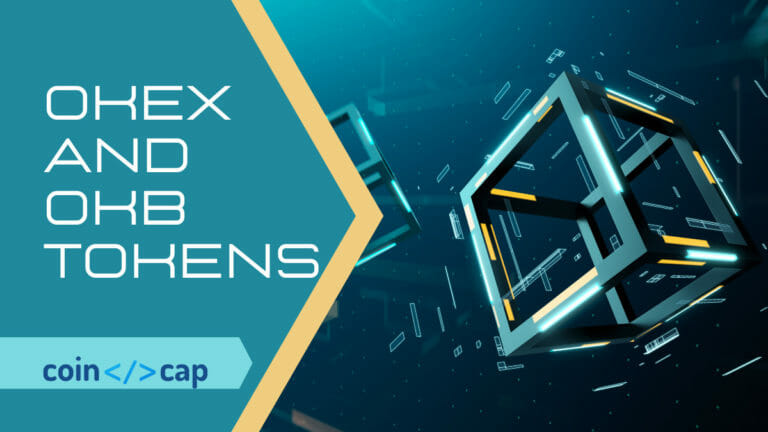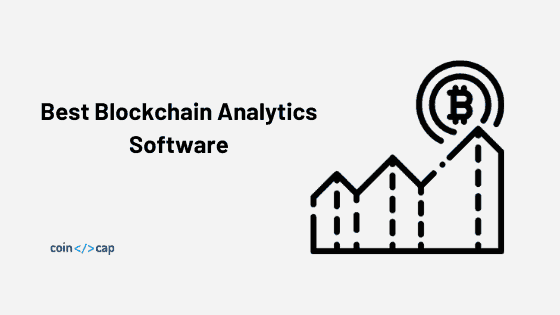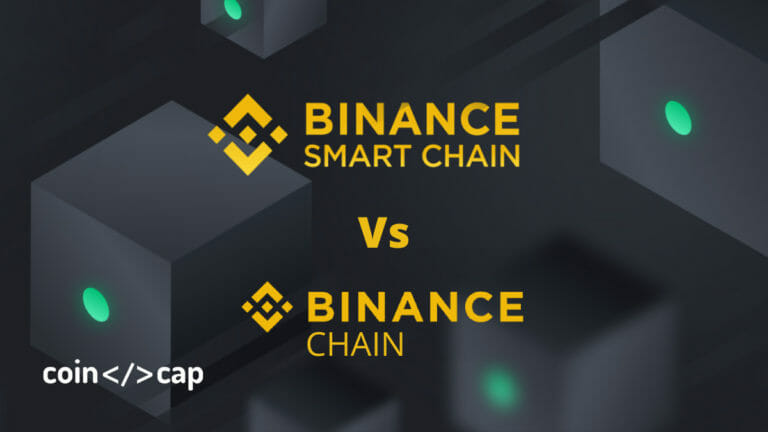Imagine blockchain networks as separate islands, each with its unique features and rules. These islands represent different blockchains, like Ethereum, Binance Smart Chain, or Polygon. Now, picture valuable items (digital assets or data) on one island that you want to use on another island.
Here’s where bridges come in. A bridge acts like a magical pathway or connection between these islands. It allows you to move your items from one island to another, making them usable in different places. This movement is secure and follows certain rules to ensure everything stays safe.
Now, think of these items as digital money or special tokens. If you earn tokens on Island A but want to spend them on Island B, the bridge helps you transfer them seamlessly. It’s like having a single currency that works across multiple islands.

Bridges make blockchains work together, letting you enjoy the benefits of different islands without being stuck on just one. They make the entire blockchain world more connected and convenient, just like bridges in the real world connect different places. So, with bridges, you have the freedom to use your digital assets wherever you need them in the vast world of blockchain!
You get my point, let’s dive deeper into it now : )
Bridges in the context of blockchain networks refer to mechanisms or protocols that enable the transfer of assets or information between two different blockchain ecosystems. Bridges in the blockchain space refer to protocols or mechanisms that facilitate the interoperability between different blockchain networks.
The primary purpose of these bridges is to enable the seamless transfer of digital assets or data across disparate blockchains, enhancing overall network connectivity. The concept revolves around creating a link between two or more blockchain ecosystems, allowing users to leverage the features and capabilities of multiple networks.
Key Aspects of Bridges
- Interoperability: Bridges play a crucial role in achieving interoperability by establishing connections between different blockchain networks. This interoperability enables users to transfer assets, tokens, or data across various platforms.
- Asset Transfer: One of the main functions of bridges is to facilitate the transfer of digital assets between blockchains. This transferability is essential for users who want to utilize assets on different networks without being restricted to a single blockchain.
- Scalability Solutions: Some bridges contribute to scaling solutions by connecting Layer 2 solutions or sidechains with the main blockchain. This helps in improving scalability, reducing transaction costs, and enhancing the overall efficiency of blockchain networks.
- Decentralized Exchange (DEX) Connectivity: Certain bridges operate in conjunction with decentralized exchanges, allowing users to trade assets seamlessly across different blockchains. This enhances liquidity and accessibility for users who want to engage in decentralized trading.
- Security and Audits: Bridges often undergo security audits to ensure the safe transfer of assets between networks. Audited and secure bridges provide users with confidence in the integrity and reliability of the transfer process.
In summary, bridges serve as vital components in the blockchain ecosystem, fostering connectivity and collaboration between diverse networks. They address the challenge of isolated blockchain islands, enabling users and developers to harness the strengths of multiple platforms.
Know more ➤ ➤ How to Transfer Tokens across Blockchains using a Bridge?
Do Ethereum bridges have transaction fees?
Yes, most Ethereum bridges involve transaction fees for locking, unlocking, or transferring assets. These fees cover the computational resources and security measures required for the bridge’s operation. Users should be aware of the fee structure before utilizing a particular bridge.
Are there risks associated with using Ethereum bridges?
While bridges employ security measures, there are risks, including smart contract vulnerabilities, network congestion, and potential centralization. Users should conduct thorough research, use well-audited bridges, and only transfer assets they are willing to risk.
Can Ethereum bridges be used for cross-chain decentralized finance (DeFi) activities?
Yes, Ethereum bridges play a crucial role in enabling cross-chain DeFi activities. They allow users to access decentralized exchanges, lending platforms, and other DeFi services on blockchains beyond Ethereum, expanding the options for users in the decentralized financial ecosystem.
How long does it take for assets to transfer through an Ethereum bridge?
The time required for asset transfers varies depending on the Ethereum bridge and the destination blockchain. Some bridges offer faster transactions, while others might take longer due to consensus mechanisms and block confirmation times. Users should check the bridge’s documentation for specific details.
Can I use Ethereum bridges for non-financial data transfer?
Yes, Ethereum bridges can be used for transferring various types of data beyond financial assets. They provide a means for interoperability between different blockchain networks, allowing the movement of information, tokens, and other digital assets.
Not able to transfer FUNDS? Check these :
➤ ➤ How to Transfer Funds from Binance to Coinbase?
➤ ➤ How to transfer Crypto from Robinhood to Binance
➤ ➤ How to transfer from Coinbase to Coinbase Pro ?
➤ ➤ How to Transfer from Uphold to Coinbase?
➤ ➤ and many more!
The Main Agenda – Top 10 Bridges on Ethereum to transfer assets
Table of Contents
Connext

Connext operates as a decentralized Layer 2 scaling solution, providing a bridge that enables users to transfer assets between Ethereum and other blockchains, including Polygon, Avalanche, and Arbitrum. The service aims to facilitate fast and low-cost transactions while maintaining security. Connext is known for its user-friendly interface and non-custodial approach, ensuring that users retain control over their assets during the transfer process.
Connext distinguishes itself with its support for various blockchains, offering users the flexibility to transfer assets across different networks. The service implements a state-of-the-art security infrastructure, including audited smart contracts, to safeguard user funds. Moreover, Connext is designed to be easily accessible, with low transaction fees, making it an attractive option for users looking for a secure and efficient cross-chain bridge solution.
Across Protocol
Across is an interoperability solution powered by intents. Intents is proving to be a winning solution in the bridging space as Across dominates the routes its supports, frequently able to provide the cheapest and fastest bridge option. Users who are pressed for time and want to get between Mainnet and L2s such as Base, zkSync, Arbitrum and Optimism in a few seconds would likely choose Across to save time and money. However, token support is limited to mostly stables and a handful of coins.
Dedicated to security, Across only transfers canonical or genuine assets for the safety of its users, instead of representative synthetic tokens that many other bridges use. For this reason, Across is only deployed on chains that have an official bridge that helps carry out its canonical token transfers under the hood. Launched in 2021, Across has an immaculate record of user security and is powered by UMA, Web3’s Optimistic Oracle.

xDAI Chain
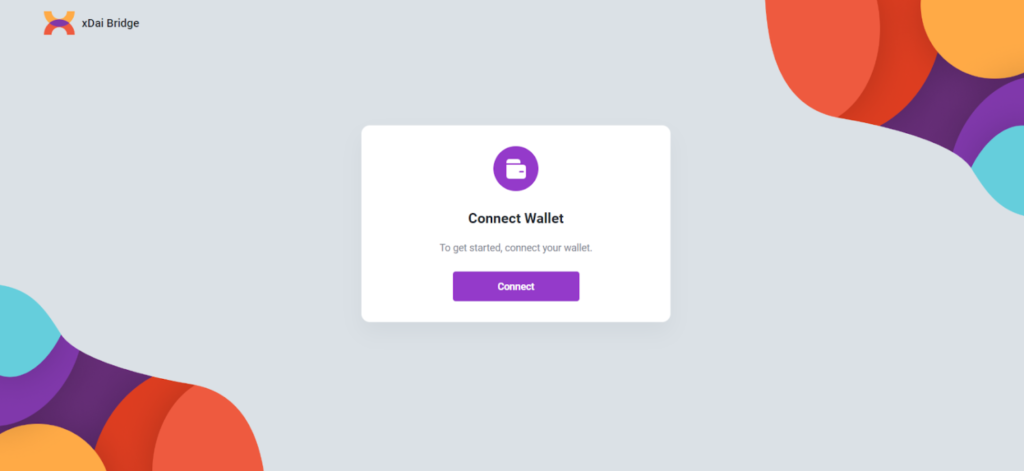
xDAI Chain operates as an Ethereum sidechain, providing a bridge for transferring assets between Ethereum and xDAI. With a focus on fast and inexpensive transactions, xDAI Chain is suitable for payments and stable tokens. The bridge aims to enhance scalability and reduce transaction costs, offering users an alternative to the main Ethereum network.
xDAI Chain stands out with its emphasis on scalability and cost-effectiveness, making it an attractive option for users seeking a more efficient transfer experience. The bridge’s support for stable tokens further expands its utility, especially in the context of decentralized finance (DeFi) applications. xDAI Chain’s commitment to delivering a seamless and economical bridge solution contributes to its uniqueness in the Ethereum ecosystem.
Also Check ➤ ➤ All about Proof of Space and Time | COMPLETE, DETAILED and FRIENDLY!
Hop Protocol

Hop Protocol functions as a decentralized bridge allowing users to transfer assets seamlessly across Ethereum and its layer 2 scaling solution, Optimistic Ethereum. The protocol is designed to optimize the efficiency and cost-effectiveness of cross-chain transfers. Hop Protocol leverages a non-custodial approach, ensuring that users maintain control over their assets throughout the process. By strategically utilizing liquidity pools, Hop Protocol aims to minimize slippage and enhance the overall experience for users looking to move their assets between Ethereum and Optimistic Ethereum.
Hop Protocol stands out for its innovative approach to liquidity management, utilizing decentralized exchanges and liquidity providers to facilitate efficient cross-chain transfers. The protocol’s focus on minimizing slippage contributes to cost savings for users. Additionally, Hop Protocol provides a straightforward and user-friendly interface, making it accessible to a broad audience, from casual users to more experienced traders. Its commitment to liquidity optimization and user-centric design positions it as a notable bridge solution in the Ethereum ecosystem.
Stargate Finance
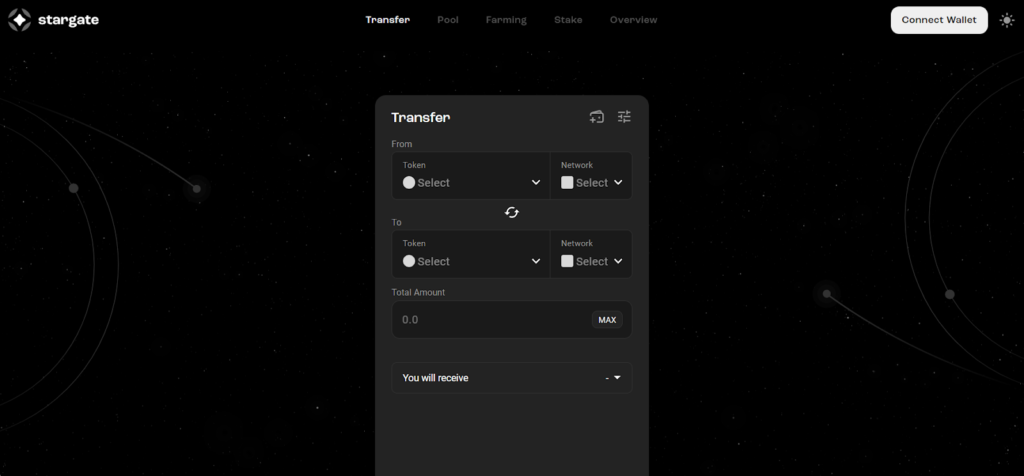
Stargate Finance operates as a cross-chain bridge, enabling users to transfer assets between Ethereum and other blockchain networks, including Binance Smart Chain, Avalanche, and Arbitrum. The platform prioritizes user-friendly interactions and aims to streamline the asset transfer process. Stargate Finance distinguishes itself by offering a range of features, including yield farming and liquidity mining, providing users with additional incentives beyond simple asset transfers.
Stargate Finance’s integration of yield farming and liquidity mining sets it apart, offering users opportunities to earn rewards while engaging in cross-chain activities. The platform’s commitment to supporting multiple blockchains expands its utility, catering to users with diverse blockchain preferences. Stargate Finance also emphasizes security and transparency, conducting regular audits to ensure the integrity of its smart contracts. Overall, its multifaceted approach positions it as a versatile bridge solution in the Ethereum ecosystem.
Also Check ➤ ➤ 20 Best SEO Tools | Level UP your GAME NOW!
Polygon

Polygon, a Layer 2 scaling solution for Ethereum, offers a bridge solution that enables users to transfer assets between the Ethereum mainnet and the Polygon network seamlessly. Polygon aims to address the scalability issues of Ethereum by providing faster and more cost-effective transactions. The bridge facilitates interoperability, allowing users to harness the benefits of both the Ethereum mainnet and the Polygon network. With a growing ecosystem and widespread adoption, Polygon’s bridge service plays a crucial role in expanding the capabilities of decentralized applications (DApps) and fostering a more scalable blockchain ecosystem.
Polygon stands out as a Layer 2 solution, enhancing transaction speed and reducing costs for users. The bridge service is integral to Polygon’s vision of creating a more scalable and efficient blockchain infrastructure. Its growing ecosystem and support from various projects contribute to the network effect, making Polygon’s bridge a pivotal component for developers and users seeking improved scalability without compromising the security of the Ethereum mainnet.
Also Check ➤ ➤ 10 Best Doc Signing Softwares | Forget Travelling; SAVE TIME NOW!
Binance Smart Chain (BSC)
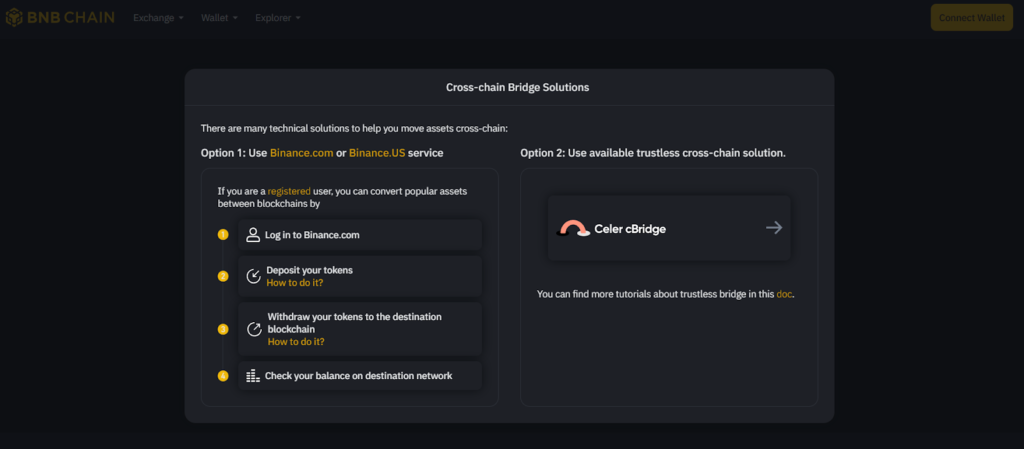
Binance Smart Chain offers a bridge solution for users looking to transfer assets between different blockchain networks, primarily connecting the Binance Smart Chain with the Ethereum mainnet. As a parallel blockchain to Binance Chain, BSC provides fast and low-cost transactions, making it an attractive option for users seeking to avoid the higher fees and slower transaction times on the Ethereum mainnet. The bridge facilitates the movement of assets, enabling users to harness the benefits of both BSC and Ethereum. BSC’s ecosystem has gained popularity for decentralized finance (DeFi) projects, decentralized applications (DApps), and other blockchain-based activities.
Binance Smart Chain’s bridge stands out for its seamless integration with the BSC ecosystem, offering users a cost-effective and efficient solution for cross-chain asset transfers. With its focus on providing a parallel blockchain experience, BSC’s bridge caters to users who prioritize transaction speed and lower costs. The platform’s popularity in the DeFi space further enhances its appeal, as users can leverage the strengths of both BSC and Ethereum for diverse blockchain activities.
Optimistic Ethereum
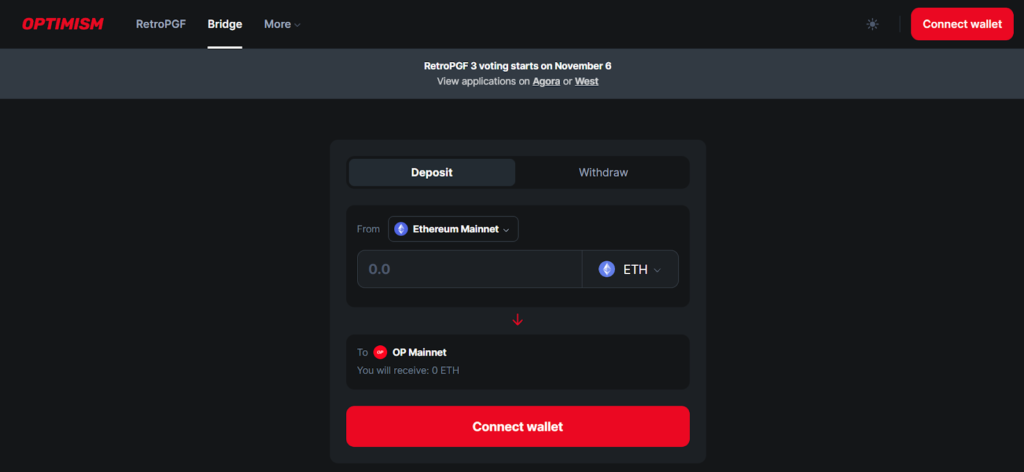
Optimistic Ethereum offers a Layer 2 scaling solution for Ethereum, aiming to enhance the scalability and efficiency of the Ethereum mainnet. The Optimistic Ethereum bridge allows users to transfer assets between the Ethereum mainnet and the Optimistic Ethereum network. Optimistic rollups, a key technology employed by OΞ, enable faster and more cost-effective transactions by processing most transactions off-chain and providing optimistic guarantees about their validity. The bridge service is pivotal in achieving interoperability between the Ethereum mainnet and Layer 2 solutions, unlocking the potential for improved scalability without compromising the security of the Ethereum network.
Optimistic Ethereum’s bridge is distinguished by its focus on Layer 2 scaling, leveraging optimistic rollups for enhanced transaction speed and reduced costs. The bridge plays a crucial role in expanding the utility of the Ethereum mainnet, offering users a seamless experience in transferring assets between the mainnet and the Optimistic Ethereum network. Optimistic Ethereum’s commitment to scalability aligns with the broader goals of addressing Ethereum’s limitations, making it an influential player in the evolution of the Ethereum ecosystem.
Also Check ➤ ➤ How to buy Amazon products using Cryptocurrency | STAND OUT!
Rainbow Bridge
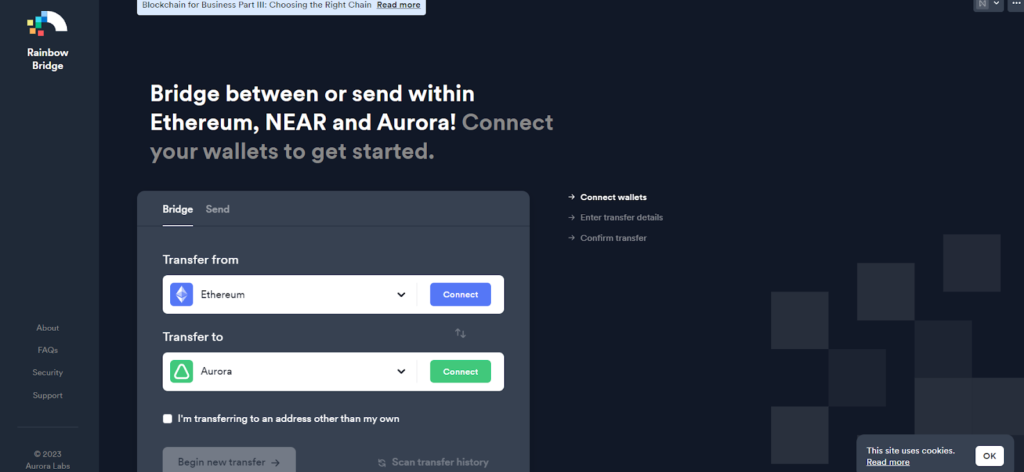
Rainbow Bridge serves as a bridge solution, enabling users to transfer assets between the Ethereum mainnet and the Gnosis Chain. Rainbow Bridge is non-custodial, allowing users to maintain control of their assets throughout the transfer process. One of its notable features is its commitment to security, having undergone audits by multiple security firms to ensure the safety of users’ assets. By facilitating the movement of assets across different blockchains, Rainbow Bridge contributes to interoperability within the broader blockchain ecosystem, connecting users and assets seamlessly.
Rainbow Bridge’s uniqueness lies in its focus on providing a secure and non-custodial bridge between Ethereum and Gnosis Chain. Users benefit from the transparency and security measures implemented by Rainbow Bridge, making it a reliable option for transferring assets. Its commitment to decentralization and security, coupled with a user-friendly interface, enhances the overall experience for users seeking a trustworthy bridge solution between Ethereum and Gnosis Chain.
Wormhole

Wormhole functions as a bridge allowing users to transfer assets between the Ethereum mainnet and the Solana blockchain. Notably, Wormhole is characterized by its high-throughput capabilities, enabling the processing of a large number of transactions per second. The bridge operates in a decentralized manner, facilitated by a consortium of validators. Users can leverage Wormhole for efficient and rapid asset transfers, taking advantage of Solana’s high-speed blockchain while still benefiting from Ethereum’s robust ecosystem.
Wormhole stands out for its high-throughput capabilities, making it a particularly efficient bridge for users transferring assets between Ethereum and Solana. The decentralized operation by a consortium of validators adds an extra layer of security and reliability to the bridge. Wormhole’s emphasis on providing a seamless experience for users, coupled with its ability to bridge the gap between Ethereum and Solana, positions it as a valuable component in the broader blockchain landscape.
Also Check ➤ ➤ Best Gaming Stations | DIVE into the BATTLE ARENA NOW!
Conclusion
In conclusion, the diverse array of bridges on Ethereum exemplifies the critical role they play in fostering connectivity and collaboration between distinct blockchain networks. These bridges act as the metaphorical pathways connecting isolated islands, enabling users to seamlessly transfer assets and data across different ecosystems. As digital assets become increasingly integral to the blockchain landscape, bridges emerge as vital components, enhancing interoperability, scalability, and overall user experience.
Each bridge discussed, from Connext’s decentralized Layer 2 scaling solution to the innovative approach of Hop Protocol and the multifaceted offerings of Stargate Finance, brings its unique strengths to the Ethereum ecosystem. xDAI Chain’s focus on fast and inexpensive transactions, Polygon’s contribution as a Layer 2 scaling solution, and Binance Smart Chain’s parallel blockchain experience showcase the versatility of these bridges.
Optimistic Ethereum’s commitment to Layer 2 scaling, Rainbow Bridge’s dedication to security and decentralization, and Wormhole’s high-throughput capabilities highlight the diverse strategies employed by these bridges. Whether users are drawn to non-custodial solutions, decentralized exchanges, or yield farming opportunities, the bridges on Ethereum cater to a wide range of preferences, contributing to the richness and dynamism of the blockchain space.
As users navigate the blockchain world, Ethereum bridges provide the freedom to utilize digital assets across different platforms, transcending the limitations of individual blockchains. However, users should remain vigilant, acknowledging the presence of transaction fees, associated risks, and the need for thorough research before engaging with specific bridges. The evolution of Ethereum bridges continues to shape the landscape of decentralized finance, decentralized applications, and blockchain interactions, paving the way for a more interconnected and accessible future in the vast world of blockchain.

